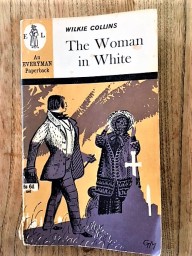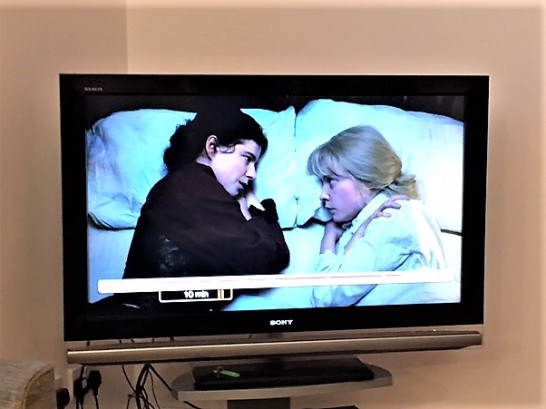I’ve just finished watching this cracker of a BBC adaptation – it’s not too late for catch up if you want to binge watch from the safety of the sofa.
 I first encountered Wilkie Collins when my family sat glued to a BBC adaptation of The Moonstone (another came in 2016). TV companies, desperate to repeat the success of The Forsyte Saga, had found a contender. They rolled him out again with The Woman in White in 1982. I read my parents’ old Everyman edition, which I’m rereading now. At university, Collins figured in lectures on Dickens, Balzac and Henry James, but The Moonstone is now more usually regarded as the first full length crime novel. The Woman in White has no detective as such and even the BBC’s enquiring “scrivener” Emmanuel Nash doesn’t appear in the book, but it too involves solving crimes and elucidating mysteries.
I first encountered Wilkie Collins when my family sat glued to a BBC adaptation of The Moonstone (another came in 2016). TV companies, desperate to repeat the success of The Forsyte Saga, had found a contender. They rolled him out again with The Woman in White in 1982. I read my parents’ old Everyman edition, which I’m rereading now. At university, Collins figured in lectures on Dickens, Balzac and Henry James, but The Moonstone is now more usually regarded as the first full length crime novel. The Woman in White has no detective as such and even the BBC’s enquiring “scrivener” Emmanuel Nash doesn’t appear in the book, but it too involves solving crimes and elucidating mysteries.
Collins works well on TV, with its tried and tested pot boiler ingredients, as effective now as in the days of steam trains and port for gentlemen in the library. Candle lit interiors of red velvet and brocade film well, and The Woman in White has not one but two isolated stately homes – Limmeridge – bright, airy, a short walk from the sea, and Blackwater, closed in around a courtyard, with neglected ancient wings and a stagnant murky lake, “just the place for a murder” as Sir Percival Glyde asserts. The word “dastardly” was made for Glyde, although it must be said that his birth is the source of all his wrongdoing and 21st century readers may glimpse sympathy from Collins for a flaw that, nowadays, isn’t one.
Collins’ characters are rounded, with varying motives, vacillations, points when their choices blur. As Walter Hartright, the artist turned amateur detective, says: “the best men are not consistent in good- why should the worst men be consistent in evil?” Walter is young, open hearted, romantic, generous – but also indecisive, naive and impulsive. The otherwise admirable Marion makes a crucial mistake in banishing him before Laura’s marriage. Foul Mrs Catherick, to a less moralising era, seems unpleasant rather than cruel, shipwrecked by unwanted pregnancy. Housekeepers and valets are not just goodies or baddies, but confused, conflicted, put upon characters whose economic dependence gives them little space for manoeuvre, compassionately observed by Collins. Most servants are trustworthy, whereas aristocrats Count and Countess Fosco and Philip and Frederick Fairlie behave unforgivably and social values help them get away with it. Fosco was more elegant on screen than in the book, where his white mice, his “low, oily smile”, his age and obesity make him less appealing. The BBC emphasized the sexual frisson between him and active, intelligent Marion Halcombe which the acting was good enough to make convincing, but it’s less reciprocated by Marion in the book. Fosco’s admiration for Marion, and his expressed sympathy for his own wife, forced to “love, honour and obey” him while watching his infatuation, redeem him slightly.
Mothers in The Woman in White are either dead or betray their daughters – Hartright’s mother, though, is steadfast and sensible. He’s the poor but honest artist, in love with fey piano playing Laura Fairlie, whose doppelganger is a madwoman escaped from yet another isolated building, a “private asylum” (and is she really mad?). To complete the gothic picture there are inheritances, sinister marriages, debt, alcoholism, a powder that sends tea drinkers to sleep, a tumbledown boathouse, lodgings in a London slum, anonymous letters, a locked church in a near abandoned village, a graveyard, jewelled keepsakes…At Limmeridge dresses swish, and Hartright observes women’s bodies moving in freedom: “…her waist, perfection in the eyes of a man, for it occupied its natural place, it filled out its natural circle, it was visibly and delightfully undeformed by stays.” But at Blackwater corsets are laced ever tighter, and I lost count of the rooms Laura, Anne, Marion, Fanny and possibly others were locked away in. In the end locks and keys turn against at least one gaoler though, because this is a novel of justice and reparation.
Collins, states my edition’s 1963 introduction, “was a radical feminist”. Possibly not quite one we’d recognise, since his female characters miss no opportunity to denigrate their own sex. Marion, is energetic, intelligent, graceful and ugly, and in her first speech of introduction she blames her own stupid behaviour/attitudes/beliefs on being a woman at least six times, adding “no woman does think much of her own sex, though few of them confess it as freely as I do.” However, the broader premise on which the book is based unambiguously protests against the lack of opportunities and legal status of women and wives in Collins’ day. All Laura’s assets will be signed over when she marries Sir Percival, the family solicitors objections waved aside, although it puts her husband in a position to benefit more from her death than her life. Her father chose the husband for her, and the BBC version gave Mrs Catherick lines similar to “To men like that, character and reputation mean more than anyone’s feelings or well being” although I couldn’t find them in the book. Collins highlights how women were subjected to coercion, violence and emotional abuse, how men fathered children and walked away, how easy it was to portray women as mad or unreliable, and how the a gentleman’s word carried more weight than someone of lower social standing. The legal position regarding the property of married women may have changed (although as late as the 1970s Carmen Callil remembers the header on her tax return: “If you have a husband, this form is addressed to him.”) but, sadly, the other types of abuse are as familiar as they were when The Woman in White was published in 1859.

Skimming the book again, I’ve the impression of a faithful adaptation, with some aspects emphasised as they couldn’t be in Collins’ time. His discussion of dreams, memory loss, post traumatic stress prefigured Freud by forty years and give the BBC cast some wonderful acting opportunities. The emphasis on dependency is there, and also the hints of lesbianism and erotica. Says Marian: “The simple illusions of her girlhood are gone, and my hand has stripped them off. Better mine than his – that is all my consolation – better mine than his.” Marian and Laura, who are half sisters through their mother, frequently share a bed. They touch, stroke and caress; their language about each other is romantic. The BBC even has Marion wearing wide legged trousers. In Anne Catherick’s case, there’s confusion between her mental health and learning difficulties, as in the book. There’s clear economic delineation. We know who is wealthy, who only appears so, who can aspire to be self sufficient, who is respectable and who is precariously surviving, down to the last sextons too debilitated to tend the graves in their charge. And here are public institutions: impoverished half derelict churches whose small congregations graffitti their doors, free village schools for urchins as opposed to foreign boarding schools for aristocrats. (Not a huge amount changed there, then either.)
Many characters and devices in The Woman in White were based on a real case, the Douhault conspiracy in France. Anyone interested in Victorians solving real life crime, and the influence this had on fiction, should read Kate Summerscale’s The Suspicions of Mr Whicher”. Another contemporary writer with a debt to Collins is Philip Pullman in his Sally Lockhart series – if you’re looking for a strong female lead with full Victorian trimmings, you can’t do better. Meanwhile, if this was your teenage children’s introduction to The Woman in White, do reassure them there’ll probably be another one along in a couple of decades. She’s one literary ghost who will never fade away.
©Jessica Norrie 2018






I remember the Forsyte Saga, much beloved of my parents, and loved “The Woman in White” when I read it as part of my own teenage “Victorian Novels only” phase.
Enjoyed the lovely review to as ever
LikeLiked by 1 person
Thank you!
LikeLike
Thank you Sally! No internet this weekend so couldn’t say so before. But you are right to be enthusiastic about this book and adaptation.
LikeLike
I loved this series and your well-written review complements it perfectly… A great review 🙂
LikeLiked by 1 person
Thank you!
LikeLike
Reblogged this on Smorgasbord – Variety is the spice of life and commented:
As usual on a Friday, I wander over to Jessica Norrie’s abode and sit for a while and enjoy her latest post on literature. This week, she compares the recent BBC series of The Woman in White with the novel by Wilkie Collins.. she noted where the script might have elaborated on the original or characters were created. Jessica also explores the loss of any form of independence on marriage with regard to money, property and even children. If you have not read the book then it would seem the televised version has much to recommend it.. as I do the post.
LikeLike